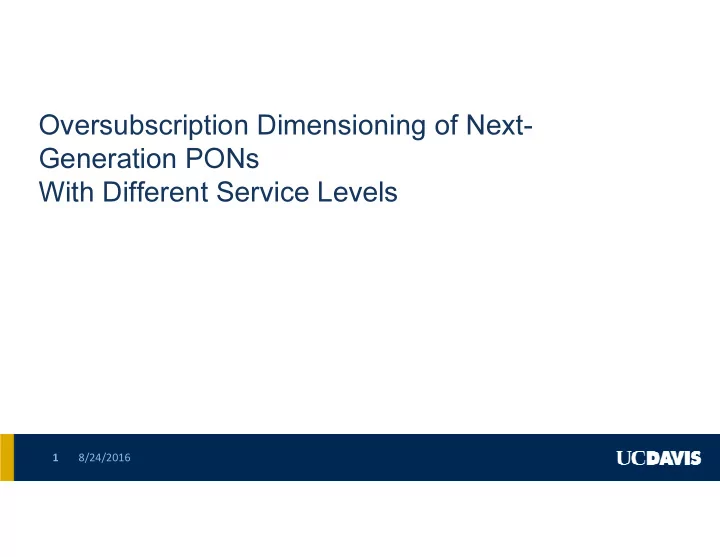

Oversubscription Dimensioning of Next- Generation PONs With Different Service Levels 8/24/2016 1
Overview • Planning PONs using oversubscription concept and shows its applicability in the dimensioning of 1 Gb/s access • With 2 types of users - basic (residential) and premium (business) with different service level requirements and activity patterns • Show that only next-generation PON networks can reach a large number of users with acceptable service levels 8/24/2016 2
Residential and Non-Residential Users • 1 Gb/s downstream Internet access to both residential and business customers • Residential customers use it as means to enhance their experience, given increasing devices • Business services or wireless backhaul, require better service levels than conventional basic connections, in particular, low-latency and higher bandwidth guarantees 8/24/2016 3
PONs • PON is choice in medium and long term due to its speed and cost-effectiveness • GPON and EPON are becoming widely spread in the access network, and their next-generations have been recently standardized • OLT arbitrates access to the shared media thanks to a Dynamic Bandwidth Allocation algorithm which allocates transmission windows to users in a TDM-based sharing model • Total bandwidth is shared between all users in a dynamic fashion, allowing assignment to only to active users as needed 8/24/2016 4
Oversubscription Model • Only few number of subscribers are simultaneously active allowing network designers apply oversubscription models and leverage statistical multiplexing gains • Question is to what extent residential and business users can be mixed on the same PON while maintaining SLAs • Show that only Next-Generation PON networks can reach a large number of users (split ratio 1:256) with acceptable service levels 8/24/2016 5
Overview of TDM-PON Technologies • Both GPON and XG-PON networks use one wavelength for downstream and another one for upstream shared by TDM • TWDM-PON stacks four or eight XG-PONs on different wavelengths (4 × 10G/2.5G, or 8 × 10G/2.5G). • Both GPON and XG-PON may coexist on the same ODN, but the wavelength plans of TWDM-PON does not allow GPON or XG-PON users on the same ODN 8/24/2016 6
Capacity Planning With Oversubscription For Single Class • N refer to the maximum number of users physically attached to the same PON branch • User activity is two-state Bernoulli processes, i.e. active with probability q or idle with probability 1− q random time, X follows a Binomial distribution X ∼ B(N, q) • X refer to the random variable that considers the number of active users at a given • B denote the rate observed per individual user in the PON branch, as follows: B = min{ C/X, B peak } • C is the total offered bandwidth capacity of each NG-PON technology B peak is the maximum (peak) bandwidth rate provided to the users • When all users are active ( X = N ), all users experience the minimum guaranteed bandwidth rate C/N, when k users are active C/k bandwidth is available 8/24/2016 7
Important Metrics Users and operators are interested in two metrics regarding bandwidth: average value E(B) perceived by active users and percentage of time β whereby a certain peak bandwidth B peak is guaranteed 8/24/2016 8
• When q = 15%, XG-PON significantly improves the results of GPON providing B peak during a large percentage of time, allowing split ratios of up to 1:64. • TWDM-PON provides at least 1 Gb/s during nearly 100% of the time for split ratios up to 1:128 and may even reach 1:256 with good performance ( β = 63% and E(B) = 929 Mb/s) • When large user activity periods are expected, for instance q = 50%, only TWDM-PON can reach up to 64 users with a minimum of B peak during 20% of the time. 8/24/2016 9
8/24/2016 10
Modelling With 2 User Types • Basic users that show low values of q and demand Bpeak only during a low value of β , and (2) premium users that show large values of q and require Bpeak guaranteed during βmin = 100% of the time • Maximum number of premium users Np is limited to: Np = C/B peak • Every pair (Np, Nb) where Np + Nb is a power of two, we need to compute the percentage of time where the basic users receive Bpeak : 8/24/2016 11
• TWDM-PON, the calculus can be reused from the XG-PON results, since TWDM-PON is in fact a stacking of four or eight XG-PONs on different wavelengths. • For instance, 40G-TWDM-PON with split 1:128 is essentially a stacking of four XG-PONs on four different wavelenghts, thus allowing 32 users per lambda (4 × 32) • 80G-TWDM-PON with split 1:256 gives the same numbers as XG-PON (1:32) • Thus, at most ten business users can be located on the same wavelength of a TWDM-PON (i.e. 40 business total for 40G-TWDM-PON and 80 business users for 80G-TWDM-PON) 8/24/2016
8/24/2016 13
Conclusion • GPON provides good results for splits 1:8 and 1:16, but cannot meet the requirements for 1:32 and beyond. XG-PON is recommended for splits 1:32 and even 1:64 with a moderate number of premium Users • 40G-TWDM-PON shows the same performance, but for splits 1:128 and 1:256, but 80G-TWDM-PON con go beyond these numbers and even reach 512 users. • TWDM-PONs provide the best performance results and highest number of connected users. • TWDM-PONs are cost-effective technologies in dense urban areas, where the average distance between the ONUs and the OLT is small and the Optical Distribution Network (ODN) can be shared by a large number of customers, not that much in rural areas 8/24/2016 14
Recommend
More recommend